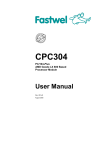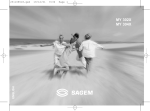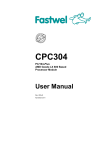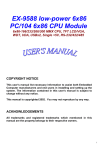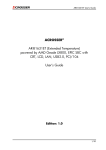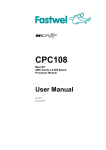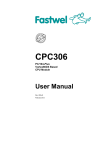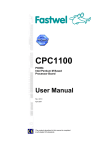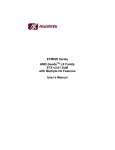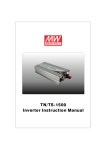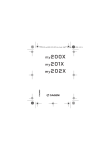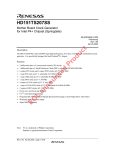Download CPB904 User Manual 001 E
Transcript
CPB904 ETX AMD Geode LX 800 Based Computer-on-Module User Manual Rev. 001 E March 2008 P r e l i m i n a r y Product Title: CPB904 Document name: CPB904 User Manual Manual version: 001 E Copyright © 2008 Fastwel Co. Ltd. All rights reserved. Revision Record Rev. Index Brief Description of Changes Board Index Date of Issue 001 Initial preliminary version CPB904, KIB1282 March 2008 Contact Information Fastwel Co. Ltd Fastwel Corporation US Address: 108 Profsoyuznaya st., Moscow 117437, Russian Federation 45 Main Street Suite 319 New York, 11201 USA Tel.: +7 (495) 232-1681 +1 (718) 554-36-86 Fax: +7 (495) 232-1654 +1 (718) 797-06-00 E-mail: [email protected] mailto:[email protected] Web: http://www.fastwel.com/ CPB904 Table of Contents Table of Contents.................................................................................................................................................. 0-1 List of Tables......................................................................................................................................................... 0-2 List of Figures ....................................................................................................................................................... 0-2 Notation Conventions............................................................................................................................................ 0-3 General Safety Precautions .................................................................................................................................. 0-4 Unpacking, Inspection and Handling..................................................................................................................... 0-5 Three Year Warranty ............................................................................................................................................ 0-7 1 Introduction......................................................................................................................................... 1-1 1.1 1.2 1.3 1.4 2 Technical Specifications ................................................................................................................... 2-1 2.1 2.2 2.3 2.4 2.5 2.6 3 General...................................................................................................................................................... 2-1 Power Requirements ................................................................................................................................. 2-2 Environmental............................................................................................................................................ 2-3 Mechanical ................................................................................................................................................ 2-3 Dimensions and Weight............................................................................................................................. 2-3 MTBF......................................................................................................................................................... 2-3 External Connections ........................................................................................................................ 3-1 3.1 3.2 3.3 4 Module Introduction ................................................................................................................................... 1-1 CPB904 Versions ...................................................................................................................................... 1-2 Delivery Checklist ...................................................................................................................................... 1-3 Supplementary Information........................................................................................................................ 1-3 1.4.1 Related Documents .................................................................................................................. 1-3 Safety Regulations..................................................................................................................................... 3-1 Connection of Peripheral Devices.............................................................................................................. 3-2 Software Installation .................................................................................................................................. 3-2 Functional Description ...................................................................................................................... 4-1 4.1 4.2 4.3 C P B 9 0 4 Structure and Layout ................................................................................................................................. 4-1 Address Mapping....................................................................................................................................... 4-4 4.2.1 Memory Addressing .................................................................................................................. 4-4 4.2.2 I/O Addressing .......................................................................................................................... 4-4 4.2.3 Interrupt settings ....................................................................................................................... 4-5 4.2.4 DMA Channels.......................................................................................................................... 4-6 Functional Description ............................................................................................................................... 4-6 4.3.1 Microprocessor ......................................................................................................................... 4-6 4.3.2 SDRAM Memory....................................................................................................................... 4-6 4.3.3 PCI and ISA Buses ................................................................................................................... 4-6 4.3.4 Reserved Flash BIOS ............................................................................................................... 4-7 4.3.5 UIDE Interface .......................................................................................................................... 4-7 4.3.6 NAND Flash.............................................................................................................................. 4-7 4.3.7 MiniSD Socket .......................................................................................................................... 4-7 4.3.8 Video Controller and Connection of Monitors ........................................................................... 4-8 4.3.9 Audio Controller ........................................................................................................................ 4-8 4.3.10 Watchdog Timer and Power Votage Monitoring ....................................................................... 4-8 4.3.11 PS/2 Keyboard and Mouse Interface ........................................................................................ 4-8 4.3.12 USB Interface ........................................................................................................................... 4-8 U s e r M a n u a l 0-1 © 2 0 0 8 F a s t w e l v . 0 0 1 E CPB904 4.3.13 Fast Ethernet Interface ............................................................................................................. 4-9 4.3.14 Serial Ports ............................................................................................................................... 4-9 4.3.15 FDD/LPT Port ........................................................................................................................... 4-9 4.3.16 RTC and Serial FRAM .............................................................................................................. 4-9 4.3.17 LED Indicator ............................................................................................................................ 4-9 4.3.18 Discrete Input/Output .............................................................................................................. 4-10 4.3.19 Power Supply Connector ........................................................................................................ 4-10 4.3.20 ETX Connectors ..................................................................................................................... 4-10 Overall and Mounting Dimensions ........................................................................................................... 4-13 4.4 5 General Software® BIOS ................................................................................................................... 5-1 5.1 BIOS Setup Program. Introduction ............................................................................................................ 5-1 List of Tables Table 1.1: Table 1.2: Table 1.3: Table 4.1: Table 4.2: Table 4.3: Table 4.4: Table 4.5: Table 4.6: Table 4.7: Table 4.8: CPB904 Versions ...................................................................................................................................... 1-2 CPB904 Supplied Set ................................................................................................................................ 1-3 Related Publications .................................................................................................................................. 1-3 Memory Address Mapping......................................................................................................................... 4-4 I/O Address Space..................................................................................................................................... 4-4 Interrupt Settings ....................................................................................................................................... 4-5 DMA Request Map .................................................................................................................................... 4-6 X1 ETX Connector Pinout........................................................................................................................ 4-10 X2 ETX Connector Pinout........................................................................................................................ 4-11 X3 ETX Connector Pinout........................................................................................................................ 4-11 X4 ETX Connector Pinout........................................................................................................................ 4-12 List of Figures Figure 1.1: Figure 3.1: Figure 4.1: Figure 4.2: Figure 4.3: Figure 4.4: CPB904 Module Appearance .................................................................................................................... 1-2 KIB1282 Baseboard Appearance .............................................................................................................. 3-2 CPB904 Block Diagram ............................................................................................................................. 4-1 Top Side: Connectors and Main Components Layout ............................................................................... 4-3 Bottom Side: Connectors and Main Components Layout .......................................................................... 4-3 CPB904 Top Side: Overall and Mounting Dimensions ............................................................................ 4-13 All information in this document is provided for reference only, with no warranty of its suitability for any specific purpose. This information has been thoroughly checked and is believed to be entirely reliable and consistent with the product that it describes. However, Fastwel accepts no responsibility for inaccuracies, omissions or their consequences, as well as liability arising from the use or application of any product or example described in this document. Fastwel Co. Ltd. reserves the right to change, modify, and improve this document or the products described in it, at Fastwel's discretion without further notice. Software described in this document is provided on an “as is” basis without warranty. Fastwel assumes no liability for consequential or incidental damages originated by the use of this software. This document contains information, which is property of Fastwel Co. Ltd. It is not allowed to reproduce it or transmit by any means, to translate the document or to convert it to any electronic form in full or in parts without antecedent written approval of Fastwel Co. Ltd. or one of its officially authorized agents. Fastwel and Fastwel logo are trademarks owned by Fastwel Co. Ltd., Moscow, Russian Federation. Ethernet is a registered trademark of Xerox Corporation. IEEE is a registered trademark of the Institute of Electrical and Electronics Engineers Inc. Intel is a trademark of Intel Corporation. Geode is trademark of AMD. ETX and ETXexpress are trademarks or registered trademarks of Kontron Embedded Modules GmbH. Microsoft is a trademark of the Microsoft corporation. In addition, this document may include names, company logos and trademarks, which are registered trademarks and, therefore, are property of their respective owners. Fastwel welcomes suggestions, remarks and proposals regarding the form and the content of this Manual. C P B 9 0 4 U s e r M a n u a l 0-2 © 2 0 0 8 F a s t w e l v . 0 0 1 E CPB904 Notation Conventions Warning, ESD Sensitive Device! This symbol draws your attention to the information related to electro static sensitivity of your product and its components. To keep product safety and operability it is necessary to handle it with care and follow the ESD safety directions. Warning! This sign marks warnings about hot surfaces. The surface of the heatsink and some components can get very hot during operation. Take due care when handling, avoid touching hot surfaces! Caution: Electric Shock! This symbol warns about danger of electrical shock (> 60 V) when touching products or parts of them. Failure to observe the indicated precautions and directions may expose your life to danger and may lead to damage to your product. Warning! Information marked by this symbol is essential for human and equipment safety. Read this information attentively, be watchful. Note... This symbol and title marks important information to be read attentively for your own benefit. C P B 9 0 4 U s e r M a n u a l 0-3 © 2 0 0 8 F a s t w e l v . 0 0 1 E CPB904 General Safety Precautions This product was developed for fault-free operation. Its design provides conformance to all related safety requirements. However, the life of this product can be seriously shortened by improper handling and incorrect operation. That is why it is necessary to follow general safety and operational instructions below. Warning! All operations on this device must be carried out by sufficiently skilled personnel only. Warning! When handling this product, special care must be taken not to hit the heatsink (if installed) against another rigid object. Also, be careful not to drop the product, since this may cause damage to the heatsink, CPU or other sensitive components as well. Please, keep in mind that any physical damage to this product is not covered under warranty. Note: This product is guaranteed to operate within the published temperature ranges and relevant conditions. However, prolonged operation near the maximum temperature is not recommended by Fastwel or by electronic chip manufacturers due to thermal stress related failure mechanisms. These mechanisms are common to all silicon devices, they can reduce the MTBF of the product by increasing the failure probability. Prolonged operation at the lower limits of the temperature ranges has no limitations. Caution, Electric Shock! Before installing this product into a system and before installing other devices on it, always ensure that your mains power is switched off. Always disconnect external power supply cables during all handling and maintenance operations with this module to avoid serious danger of electrical shock. C P B 9 0 4 U s e r M a n u a l 0-4 © 2 0 0 8 F a s t w e l v . 0 0 1 E CPB904 Unpacking, Inspection and Handling Please read the manual carefully before unpacking the module or mounting the device into your system. Keep in mind the following: ESD Sensitive Device! Electronic modules and their components are sensitive to static electricity. Even a non-perceptible by human being static discharge can be sufficient to destroy or degrade a component's operation! Therefore, all handling operations and inspections of this product must be performed with due care, in order to keep product integrity and operability: Preferably, unpack or pack this product only at EOS/ESD safe workplaces. Otherwise, it is important to be electrically discharged before touching the product. This can be done by touching a metal part of your system case with your hand or tool. It is particularly important to observe anti-static precautions when setting jumpers or replacing components. If the product contains batteries for RTC or memory back-up, ensure that the module is not placed on conductive surfaces, including anti-static mats or sponges. This can cause shortcircuit and result in damage to the battery and other components. Store this product in its protective packaging while it is not used for operational purposes. Unpacking The product is carefully packed in an antistatic bag and in a carton box to protect it against possible damage and harmful influence during shipping. Unpack the product indoors only at a temperature not less than +15°C and relative humidity not more than 70%. Please note, that if the product was exposed to the temperatures below 0°С for a long time, it is necessary to keep it at normal conditions for at least 24 hours before unpacking. Do not keep the product close to a heat source. Following ESD precautions, carefully take the product out of the shipping carton box. Proper handling of the product is critical to ensure correct operation and long-term reliability. When unpacking the product, and whenever handling it thereafter, be sure to hold the module preferably by the front panel, card edges or ejector handles. Avoid touching the components and connectors. Retain all original packaging at least until the warranty period is over. You may need it for shipments or for storage of the product. Initial Inspection Although the product is carefully packaged, it is still possible that shipping damages may occur. Careful inspection of the shipping carton can reveal evidence of damage or rough handling. Should you notice that the package is damaged, please notify the shipping service and the manufacturer as soon as possible. Retain the damaged packing material for inspection. After unpacking the product, you should inspect it for visible damage that could have occurred during shipping or unpacking. If damage is observed (usually in the form of bent component leads or loose socketed components), contact Fastwel's official distributor from which you have purchased the product for additional instructions. Depending on the severity of the damage, the product may even need to be returned to the factory for repair. DO NOT apply power to the product if it has visible damage. Doing so may cause further, possibly irreparable damage, as well as result in a fire or electric shock hazard. C P B 9 0 4 U s e r M a n u a l 0-5 © 2 0 0 8 F a s t w e l v . 0 0 1 E CPB904 If the product contains socketed components, they should be inspected to make sure they are seated fully in their sockets. Handling In performing all necessary installation and application operations, please follow only the instructions supplied by the present manual. In order to keep Fastwel’s warranty, you must not change or modify this product in any way, other than specifically approved by Faswel or described in this manual. Technical characteristics of the systems in which this product is installed, such as operating temperature ranges and power supply parameters, should conform to the requirements stated by this document. Retain all the original packaging, you will need it to pack the product for shipping in warranty cases or for safe storage. Please, pack the product for transportation in the way it was packed by the supplier. When handling the product, please, remember that the module, its components and connectors require delicate care. Always keep in mind the ESD sensitivity of the product. C P B 9 0 4 U s e r M a n u a l 0-6 © 2 0 0 8 F a s t w e l v . 0 0 1 E CPB904 Three Year Warranty Fastwel Co. Ltd. (Fastwel), warrants that its standard hardware products will be free from defects in materials and workmanship under normal use and service for the currently established warranty period. Fastwel’s only responsibility under this warranty is, at its option, to replace or repair any defective component part of such products free of charge. Fastwel neither assumes nor authorizes any other liability in connection with the sale, installation or use of its products. Fastwel shall have no liability for direct or consequential damages of any kind arising out of sale, delay in delivery, installation, or use of its products. If a product should fail through Fastwel's fault during the warranty period, it will be repaired free of charge. For out of warranty repairs, the customer will be invoiced for repair charges at current standard labor and materials rates. Warranty period for Fastwel products is 36 months since the date of purchase. The warranty set forth above does not extend to and shall not apply to: 1. Products, including software, which have been repaired or altered by other than Fastwel personnel, unless Buyer has properly altered or repaired the products in accordance with procedures previously approved in writing by Fastwel. 2. Products, which have been subject to power, supply reversal, misuse, neglect, accident, or improper installation. Returning a product for repair 1. Apply to Fastwel company or to any of the Fastwel's official representatives for the Product Return Authorization. 2. Attach a failure inspection report with a product to be returned in the form, accepted by customer, with a description of the failure circumstances and symptoms. 3. Carefully package the product in the antistatic bag, in which the product had been supplied. Failure to package in antistatic material will VOID all warranties. Then package the product in a safe container for shipping. 4. The customer pays for shipping the product to Fastwel or to an official Fastwel representative or dealer. C P B 9 0 4 U s e r M a n u a l 0-7 © 2 0 0 8 F a s t w e l v . 0 0 1 E Introduction 1 CPB904 Introduction This document presents general information on CPB904 processor module, the details of its proper and safe installation, configuration and operation. 1.1 Module Introduction CPB904 is an ETX computer-on-module (COM), highly integrated and compact single board computer for use in systems requiring low power consumption and wide operating temperature range. All I/O signals as well as full realization of ISA and PCI buses are mapped to four standard high density, low profile connectors on the bottom side of the module. CPB904 is designed for use in applications being mounted on an ETX baseboard. CPB904 is based on low power AMD Geode LX800 CPU and AMD CS5536AC I/O companion. Dynamic Memory interface supports 64-bit DDR SDRAM via SODIMM socket and soldered 128 or 256 MB memory bank. All key components including CPU, chipset, memory, and periphery controllers are soldered on-board providing excellent vibration stability and increased efficiency of protective conformal coating. CPB904 offers wide variety of data display capabilities. It allows simultaneous operation of standard VGA interface, 24-bit LVDS interface, and 18-bit interface for TFT or DSTN LCD panels connection. In addition TV output is available. Data storage subsystem is based on single-channel IDE controller, that is able to drive up to two IDE devices: two external hard drives, CompactFlash card. For data exchange, CPB904 uses one independent Fast Ethernet port, three COM ports, four USB 2.0 ports, IrDA port, and parallel port combined with FDD and with 17 programmable discrete input/output lines. System control and management capabilities of CPB904 include watchdog timer, reserved BIOS, and possibility to save system configuration and emergency parameters in FRAM chip. CPB904 is manufactured in three versions: CPB904-01 (256 MB of soldered system memory), CPB904-02 (512 MB soldered), and CPB904-03 with SODIMM socket for up to 512 MB DDR SDRAM. CPB904 is designed for operation within industrial temperature range from –40 C to +85°C. CPB904 supports wide range of operating systems – Fastwel DOS (MS DOS-compatible), Windows XP embedded, QNX 4.25 and 6.3x, Linux 2.4, and Windows CE.NET 4.2. C P B 9 0 4 U s e r M a n u a l 1-1 © 2 0 0 8 F a s t w e l v . 0 0 1 E Introduction CPB904 Figure 1.1: CPB904 Module Appearance The appearance may vary for different versions of the module. 1.2 CPB904 Versions At the present time the CPB904 module is manufactured in three versions differing in system memory size. Table 1.1: CPB904 Versions Version Decimal ID CPB904-01 256 MB DDR SDRAM soldered memory CPB904-02 512 MB DDR SDRAM soldered memory CPB904-03 SODIMM socket for DDR SDRAM, no soldered memory C P B 9 0 4 U s e r M a n u a l 1-2 © 2 0 0 8 F a s t w e l v . 0 0 1 E Introduction 1.3 CPB904 Delivery Checklist Table 1.2: CPB904 Supplied Set Code Description Note CPB904-01 CPB904-02 CPB904-03 Processor module – CD ROM with documentation and service software Antistatic bag and consumer carton box Note: Keep the antistatic bag and the original package at least until the warranty period is over. It can be used for future storage or warranty shipments. 1.4 Supplementary Information 1.4.1 Related Documents Information related to this product and its components can be found in the following documents: Table 1.3: Related Publications Product Publication CompactFlash cards CF+ and CompactFlash Specification Revision 1.4 Processor AMD Geode™ LX Processor Reference Schematic AMD Geode™ LX Processors Data Book AMD Geode™ CS5536 Companion Device Preliminary Data Book AMD Geode™ LX Processor and CS5535/CS5536 Companion Devices Layout Recommendations Super I/O Winbond W83627HF SuperIO Data sheet C P B 9 0 4 U s e r M a n u a l 1-3 © 2 0 0 8 F a s t w e l v . 0 0 1 E Technical Specifications CPB904 2 Technical Specifications 2.1 General CPU: AMD Geode LX800 500 MHz 32-bit x86/x87 compatible core 64-bit coprocessor 64-bit memory bus, up to 400 MHz 64 KB L1, 128 KB L2 cache Integrated FPU supports the Intel MMX™ and AMD 3DNow!™ Technology instruction sets System memory 256 or 512 MB soldered SDRAM DDR333 Up to 512 MB in SODIMM socket (for CPB904-03) Flash BIOS 2x512 KB, reserved In-system modification Storage: Support for up to two UltraDMA-100 IDE devices Solid state disk: soldered, 64 MB NAND flash, with MS DOS-compatible Fastwel file system MiniSD socket on board CompactFlash (via KIB1282) Serial ports Three serial ports High speed 16C550 compatible COM1, COM2: RS232, 9 wires, up to 115.2 Kb/s COM3: RS232, TX/RX, for remote PC connection USB Four USB 2.0 channels Ethernet One Fast Ethernet port 10/100 Mb/s C P B 9 0 4 U s e r M a n u a l 2-1 © 2 0 0 8 F a s t w e l v . 0 0 1 E Technical Specifications CPB904 Video controller 2D accelerator Video memory 64 MB shared with system LCD (TFT or DSTN) panels support, resolution up to 1600×1200 at 60 Hz 18-bit color via TFT interface, 24-bit color via LVDS Analog display support, resolution 1600×1200 at 100 Hz, 1920×1440 at 85 Hz, 32-bit LVDS interface Discrete I/O 17 discrete I/O lines, shared with LPT port Watchdog timer Fixed timeout period 1.6 s Safety System configuration settings stored in CMOS+SFRAM Saving essential user data in SFRAM in case of power failure CPU temperature and voltages monitoring RTC On-board real time clock with Li battery on baseboard PS/2 PS/2 keyboard and mouse interface FDD Floppy disk interface Parallel port SPP/ECP/EPP compatible. Lines, shared with FDD controller Expansion Buses 32-bit PCI 16-bit ISA X1-X4 ETX headers Software Support: General Software® BIOS Fastwel DOS, Windows XP Embedded, QNX® 4.25 and 6.3x, Linux® 2.4, Windows CE.NET 4.2 2.2 Power Requirements The module is powered via X1-X4 ETX connectors by an external DC power source providing the following characteristics: Voltage: +5 V ±5% (from +4.75 V to +5.25 V) Consumption current (without external devices): 1.2 A Note: +5 V SB voltage is used in testing mode. +5 V voltage may be supplied via J6 connector while testing the module C P B 9 0 4 U s e r M a n u a l 2-2 © 2 0 0 8 F a s t w e l v . 0 0 1 E Technical Specifications 2.3 CPB904 Environmental Operating temperature range from: -40°C to +85°C Storage temperature: -55°C to +90°C Relative humidity: 5% to 95% at 25°С, noncondensing 2.4 Mechanical Vibration – TBD; Single shock, peak acceleration – TBD; Multiple shock, peak acceleration – TBD. 2.5 Dimensions and Weight Dimensions, not more: 114 × 95 × 11.4 mm (4.5” × 3.7” × 0.45”) Weight, not more: ~0.1 kg (TBD later) (without SODIMM memory module and MiniSD card) 2.6 MTBF MTBF for CPB904 is 200000 hours The value is calculated according to: Telcordia Issue 1 model, Method I Case 3, for continuous operation at a surface location, at normal environmental conditions (Russian State Standard GOST 15150-69, "UHL4" climatic parameters) and at ambient temperature 30°С. C P B 9 0 4 U s e r M a n u a l 2-3 © 2 0 0 8 F a s t w e l v . 0 0 1 E External Connections 3 CPB904 External Connections The following precautions must be observed to ensure proper installation and to avoid damage to the module, other system components, or harm to personnel. 3.1 Safety Regulations The following safety regulations must be observed when installing or operating the module. Fastwel assumes no responsibility for any damage resulting from infringement of these rules. Warning! When handling or operating the module, special attention should be paid to the heatsink, because it can get very hot during operation. Do not touch the heatsink when installing or removing the module. Moreover, the module should not be placed on any surface or in any kind of package until the module and its heatsink have cooled down to ambient temperature. ESD Sensitive Equipment! This product comprises electrostatically sensitive components. Please follow the ESD safety instructions to ensure module's oparability and reliability: Use grounding equipment, if working at an anti-static workbench. Otherwise, discharge yourself and the tools in use before touching the sensitive equipment. Try to avoid touching contacts, leads and components. Extra caution should be taken in cold and dry weather. C P B 9 0 4 U s e r M a n u a l 3-1 © 2 0 0 8 F a s t w e l v . 0 0 1 E External Connections 3.2 CPB904 Connection of Peripheral Devices External devices, except for MiniSD cards, are connected to CPB904 via KIB1282 ATX carrier board for ETX/XTX computer modules. Figure 3.1: KIB1282 Baseboard Appearance The appearance may vary for different versions of the module. KIB1282 baseboard provides access to the following interfaces and connectors: VGA (D-Sub connector), S-Video, LVDS, FastEthernet 10/100-BaseT (one RJ45 connector), two x1 PCI Express connectors, one 16-bit ISA and two PCI headers, USB 2.0 (four Type A connectors), IDE UltraATA, four standard SATA connectors, CF Type I/II socket with IDE interface, two RS232 COM ports, LPT and FDD standard connectors, two PS/2 connectors, two ExpressCard™ slots, Audio line in/out, HD (5+1 out) Audio Codec, two MIC, IrDA, LPC interface, SMBUS, PLCC, fan connector, control&signalling interfaces and LEDs, ATX power supply header. 3.3 Software Installation Operating system is loaded from the on-board NAND Flash memory by default. Operating system on this flash-disk is FDOS supplemented with utilities. The installation of the peripheral drivers is described in the accompanying information files. For details on installation of an operating system, please refer to the relevant software documentation. C P B 9 0 4 U s e r M a n u a l 3-2 © 2 0 0 8 F a s t w e l v . 0 0 1 E Functional Description CPB904 4 Functional Description 4.1 Structure and Layout Functional diagram of the CPB904 module is shown in Figure 4.1. CPB904 Block Diagram CRT TFT LCD (18-bit) Out to ETX CON AMD Geode LX800 Processor TFT Memory Bus ISA Out to ETX CON SODIMM200 DDR CRT Out to ETX CON 256/512 MB DDR DRAM Figure 4.1: PCI to ISA (IT8888) VCORE (1.2 V) VCCMEM (2.5 V) +5V ETX_VCC3 (3.3 V) DC/DC PCI Bus (33MHz or 66MHz) VCC3SB (3.3 V) PCI Out to ETX CON VCORE SB +5VSB IDE Out to ETX CON Primary IDE USB x 4 Out to ETX CON USB 2.0 & OTG ATA-66 10/100 Mb/s Ethernet Ethernet Out to ETX CON AC97 Codec Audio In/Out to ETX CON South Bridge (CS5536) Geode Companion Device COM3 14.318 MHz Crystal PCI (33/66 MHz) Clock Synthesizer 66 MHz LPC Bus 48 MHz (MK1491-09F) REFCLK C P B 9 0 4 U s e r M a n u a l Flash BIOS SUPER I/O (SST FWH) (W83627HF) 4-1 COM 1,2 LPT/FDD KB/MS © 2 0 0 8 F a s t w e l Out to ETX CON v . 0 0 1 E Functional Description CPB904 CPB904 includes the following main functional units: AMD Geode LX 800 500 MHz microprocessor including 32-bit x86 core, 64-bit coprocessor, 64-bit SDRAM memory bus; 256/512 MB soldered DDR SDRAM system memory, up to 512 MB in SODIMM socket (for CPB904-03); Flash memory based reserved BIOS, in-system modification; Onboard NAND flash-disk, 64 MB; IDE port with support for two UltraDMA/100 devices; MiniSD socket; Serial ports: COM1, COM2: RS232, full control, maximum exchange rate – 115.2 Kbit/s; COM3: RS232, TX/RX, for remote PC connection One Fast Ethernet channel 10/100 Mbit/s; Four USB 2.0 channels; Watchdog timer; CMOS+SFRAM for BIOS configuration storage; Real time clock with Li battery backup; PS/2 keyboard/mouse port; IrDA port; 17 programmable discrete I/O channels share lines with FDD/LPT ports. Universal parallel port supports EPP and ECP modes; Integrated graphics controller: Video memory up to 64 MB, shared with system; LCD (TFT or DSTN) panels support, resolution up to 1600x1200; Analog RGB display support; LVDS interface Layouts of main CPB904 components and connectors on top and bottom sides are presented in Figures 4.2 and 4.3 respectively. C P B 9 0 4 U s e r M a n u a l 4-2 © 2 0 0 8 F a s t w e l v . 0 0 1 E Functional Description Figure 4.2: CPB904 Top Side: Connectors and Main Components Layout necto e Con Servic R C OM3 S232 M SOD IM 2) ket (J D Soc MiniS (J4) ridge ISA B PCI to ator dic ) LED In tton (SW1 u B t e s Re rbiter PCI A BIOS ry a Prim 6 3 CS55 c Code Audio (J1) ector Conn e ic rv Se (J9) er ontroll n e t C o we r Aux P 5) (J 5VSB to 5V CP U X800 ode L Ether Ge AMD I/O Super V Con RGB/T r (J3) verter The layout may slightly differ for various versions of the board. Figure 4.3: Bottom Side: Connectors and Main Components Layout DDR M SDR A XC X4 ET r necto X Co n T E 2 X k sh Dis el Fla Fastw CPLD to onnec r necto r X Con X3 ET r necto X Co n X1 ET S rve BIO Rese LVDS itter/ m Trans rter Conve FRAM Clock rator n e G e The layout may slightly differ for various versions of the board. C P B 9 0 4 U s e r M a n u a l 4-3 © 2 0 0 8 F a s t w e l v . 0 0 1 E Functional Description CPB904 4.2 Address Mapping 4.2.1 Memory Addressing Table 4.1: Memory Address Mapping Address Range Size Description 00000h – 09FFFh 640 KB System memory A0000h – BFFFFh 128 KB Video memory C0000h – С7FFFh 32 KB Display BIOS memory or external bus memory C8000h – DBFFFh 80 KB External bus memory DC000h – DFFFFh 16 KB SMI handler E0000h – FFFFFh 128 KB System BIOS area 100000h – FFFFFFFh 255 MB Extended system memory FFFFFFFFh – 10007FFFFh 512 KB ROM BIOS area 4.2.2 I/O Addressing Table 4.2: I/O Address Space Address Range Function Note 0000h – 001Fh DMA1 – 0020h – 0021h PIC master – 0022h – 0023h LX configuration – 0028h – 002Fh Local bus – 0040h – 005Fh Timer – 0060h – 006Fh POST, keyboard shadow registers – 0070h – 007Fh CMOS, NMI mask control registers – 0080h – 009Fh DMA page registers – 00A0h – 00BFh Slave PIC – 00C0h – 00DFh DMA2 – 00F0h – 00FFh Numeric coprocessor – 0100h – 016Fh External 16-bit ISA bus External bus access 0170h – 0177h Reserved – 0180h – 01EFh External 16-bit ISA bus External bus access 01F0h – 01F7h Primary IDE – 0200h – 020Ah External 16-bit ISA bus External bus access 020Bh – 020Fh CPB904 control registers – 0210h – 026Fh External 16-bit ISA bus External bus access 0270h – 027Fh Reserved – 0280h – 02E7h External 16-bit ISA bus External bus access 02E8h – 02EFh Reserved – C P B 9 0 4 U s e r M a n u a l 4-4 © 2 0 0 8 F a s t w e l v . 0 0 1 E Functional Description CPB904 Address Range Function Note 02F8h – 02FFh COM2 RS232 0300h – 0301h CPB904 FFD – 0302h – 036Fh External 16-bit ISA bus External bus access 0370h – 0377h Reserved – 0378h – 037Fh LPT1 – 0380h – 03AFh Reserved – 03B0h – 03DFh EGA, VGA, CGA – 03E8h – 03EFh COM3 RS232 03F0h – 03F75h FDD Controller – 03F8h – 03FFh COM1 RS232 0400h – FFFFh External 16-bit ISA bus External bus access 0CF8h – 0CFFh Host PCI controller configuration registers – 4.2.3 Interrupt settings Table below presents interrupt settings. Interrupt request configuration is performed in BIOS Setup. Table 4.3: Interrupt Settings IRQ Source IRQ0 System timer IRQ1 Keyboard IRQ2 8259 interrupt IRQ3 COM2 IRQ4 COM1 IRQ5 Ethernet / USB / Audio IRQ6 FDD IRQ7 LPT IRQ8 RTC IRQ9 Ethernet / USB / Audio IRQ10 Free IRQ11 Free IRQ12 Mouse IRQ13 Reserved for math. coprocessor IRQ14 HDD, CompactFlash IRQ15 COM3 C P B 9 0 4 U s e r M a n u a l 4-5 © 2 0 0 8 F a s t w e l v . 0 0 1 E Functional Description 4.2.4 CPB904 DMA Channels Table 4.4: DMA Request Map DMA Channel Main Function Alternative Source 0 Reserved – 1 LPT DRQ1 line of external ISA bus 2 FDD – 3 DRQ3 line of external ISA bus – 4 Slave controller – 5 – – 6 – – 7 – – 4.3 Functional Description 4.3.1 Microprocessor The module is based on AMD Geode LX800 microprocessor with 1.8W typical power consumption at 500 MHz, maximum power 3.6W (TDP). The processor includes 32-bit x86 core, 64-bit coprocessor and 64-bit DDR memory bus up to 400 MHz, graphics and video controller with VGA monitors and LCD panels simultaneous operation support. FPU of the processor supports MMX™ and AMD 3DNow!™ technology instruction sets. The CPU is complemented with AMD Geode CS5536 companion device providing support for numerous I/O functions including IDE, USB, audio, and power management interfaces. 4.3.2 SDRAM Memory Four DDR 333 SDRAM memory chips are soldered on the bottom side of the PCB. Total memory size is 256 or 512 MB depending on the version of the module. In addition, the module can accept up to 512 MB of DDR SDRAM via SODIMM socket on the top side of the board (for CPB904-03). 4.3.3 PCI and ISA Buses Expansion capabilities of CPB904 are supported by 32-bit PCI bus routed to X1 ETX connector. Moreover, ITE IT8888G PCI-to-ISA bridge provides full-functional 16-bit ISA bus available via X2 ETX connector. C P B 9 0 4 U s e r M a n u a l 4-6 © 2 0 0 8 F a s t w e l v . 0 0 1 E Functional Description 4.3.4 CPB904 Reserved Flash BIOS The CPB904 takes advantage of flash-memory based BIOS. Two Flash BIOS chips have storage capacity of 512 KB each. The main (working) copy of BIOS occupies 512 KB on a chip in PLCC32 panel. Reserve BIOS copy is stored on a soldered chip and is used for emergency boot. Switching to reserve BIOS copy is performed automatically. It is possible to upgrade the main copy of BIOS in-system. It is done with the help of fwflash.exe program. For example: fwflash.exe b304v1_3.bin where b304v1_3.bin – BIOS image binary file name. BIOS can be upgraded via RS232 (COM1) serial port in console operation mode. To do so, connect COM ports of the module and of a remote PC, enable Start RS232 Manufacturing Link mode in BIOS Setup, and run fwflash.exe utility at a remote PC with the following parameters: fwflash.exe b304v1_3.bin 1 where b304v1_3.bin – BIOS image binary file name 1 – PC COM port number (COM1) 4.3.5 UIDE Interface CPB904 has one IDE ATA-5/ATAPI interface with support of PIO mode 0-4, MDMA mode 0-2, UDMA mode 0-5 including UltraDMA100. It allows connection of two UDMA-100 compatible devices (master and slave) to the primary IDE channel. External devices are connected to IDE interface via HDD connector and CompactFlash type I/II socket located on KIB1282 carrier board. 4.3.6 NAND Flash Capacity of the on-board NAND flash memory chip is 64 MB. It is available only under DOS, Windows CE, and Linux operating systems. It can be used as a bootable disk or can be disabled in BIOS Setup. Since only one IDE channel is used, it is possible to connect storage devices in one of the ways described below. Connection Variant IDE-Master IDE-Slave CF-Master CF-Slave NAND Flash 1 + + – – + 2 + – – + + 3 – + + – + Selection of disk drives operation mode (master of slave) is performed in BIOS Setup. 4.3.7 MiniSD Socket CPB904 is equipped with a MiniSD socket, located on the top side of the module. It is not used in current versions of the module. C P B 9 0 4 U s e r M a n u a l 4-7 © 2 0 0 8 F a s t w e l v . 0 0 1 E Functional Description 4.3.8 CPB904 Video Controller and Connection of Monitors The module utilizes graphics controller integrated in Geode LX CPU with the following main features: Video memory size up to 64 MB shared with system; Support of TFT or DSTN LCD-panels with resolution up to 1600×1200 at 18 bpp, LVDS panels with resolution up to 1600×1200 at 24 bpp; Support of VGA RGB monitors with resolution up to 1920×1440 (85 Hz, 32 bpp); LVDS interface CRT VGA monitors and/or LCD panels are connected to KIB1282 carrier board. Video interfaces are routed to KIB1282 via X3 ETX connector. As an option, CPB904 can be equipped with TV encoder chip providing TV Output function. 4.3.9 Audio Controller AC'97 audio codec functions are performed by Realtek ALC203 chip incorporating two channel 20-bit DAC. Audio lines are routed to X1 ETX connector. 4.3.10 Watchdog Timer and Power Votage Monitoring CPB904 has one watchdog timer with fixed timeout period of 1.6 s, which is controlled by CPLD. Watchdog timer is in "on" state on power up. Watchdog timer operation modes are switched in BIOS Setup program. Power voltage monitoring and watchdog functions are performed by ADM706T supervisor chip. +5V voltage is monitored. Reset signal is generated when +5V voltage goes down to +4.75V. 3.3 V can be monitored by Winbond W83627HF SuperIO chip using software utilities. Moreover, this chip is also used to monitor CPU temperature by means of a sensor integrated in microprocessor and board temperature using optional on-board sensor. 4.3.11 PS/2 Keyboard and Mouse Interface PS/2 keyboard and mouse interface is routed to KIB1282 baseboard via X3 connector. Keyboard and mouse are connected to separate connectors on the baseboard. 4.3.12 USB Interface The module is equipped with four USB 2.0 host ports. All channels have power control circuit. One USB device may be connected to each port. All channels are routed to KIB1282 baseboard via X1 ETX connector. C P B 9 0 4 U s e r M a n u a l 4-8 © 2 0 0 8 F a s t w e l v . 0 0 1 E Functional Description 4.3.13 CPB904 Fast Ethernet Interface CPB904 has one 10Base-TX/100Base-TX Ethernet channel provided by Intel LU82551IT controller. It is routed through X4 ETX header to KIB1282 baseboard, where Ethernet port is available via RJ45 connector. 4.3.14 Serial Ports The CPB904 is furnished with three serial ports having standard PC AT base addresses. Their operation is provided by Winbond W83627HF Super I/O chip internal UARTs. COM1 and COM2 (RS232) operate as full function 9-wire RS232 interfaces with maximum transfer rate of 115.2 Kb/s. They are fully compatible with UART16550. Both COM1 and COM2 ports are routed via X3 ETX connector to standard D-Sub connectors at KIB1282 baseboard. COM3 is available via 3-pin 2 mm pitch connector (J4) mounted on the top side of CPB904 module. It is a dedicated connector for remote PC console operation, it transfers only RXD, TXD, and GND lines. For communication with a remote PC (console operation) a null-modem cable is needed. 4.3.15 FDD/LPT Port Super I/O chip includes FDD controller and universal parallel port sharing the same lines routed via X3 ETX connector to KIB1282 baseboard connectors. Switching between LPT and FDD ports is performed in BIOS Setup. FDD port allows connection of one device. LPT port of CPB904 supports EPP and ECP operation modes. ECP is the default mode. LPT uses IRQ7 interrupt line, IRQ6 is assigned to FDD port. If "On-board LPT/FDC" parameter is set to "Disabled" in BIOS Setup, IRQ7 and IRQ6 interrupts are available for user application. 4.3.16 RTC and Serial FRAM The module is equipped with a standard Real Time Clock. FRAM is non-volatile memory with I2C serial interface. It serves as a back-up storage for BIOS Setup parameters, for critical system events information recording, and for restoration of the RTC memory if an error is detected. FRAM write access is allowed for system software only. In case of operating system crash and if BIOS Setup program can not be started, BIOS settings can be reset using CMOS_RST.COM program. It is started under MS DOS 6.22 on a remote PC connected to switched off CPB904 module with a null-modem cable via COM1 port. After this procedure, BIOS settings are reset to default on module's power-up. 4.3.17 LED Indicator CPB904 has a dual color programmable LED indicator on the top side of the module. Red light turns into green on BIOS successful loading. C P B 9 0 4 U s e r M a n u a l 4-9 © 2 0 0 8 F a s t w e l v . 0 0 1 E Functional Description 4.3.18 CPB904 Discrete Input/Output 17 programmable input/output channels use FDD/LPT port lines. 4.3.19 Power Supply Connector The power is supplied to CPB904 via ETX connectors in normal operation mode or via Aux Power connector (J6) located on the top side of the module in module's test mode only. To enable module's ability to be powered via J6 connector it is necessary to close pins on J5 pinpad. This connects +5VSB voltage to module's +5V lines. Please, observe polarity while connecting wires to J6 connector. The main power voltage of the processor module is +5V. +3.3V voltage is generated onboard, it may be used to power devices on baseboard with consumption current of up to 0.2 A. 4.3.20 ETX Connectors CPB904 is equipped with four standard ETX low-profile 100-contact Hirose connectors to supply module's interfaces to KIB1282 baseboard. The following four tables provide information on ETX connectors contacts designation. Table 4.5: Pin# 1 2 3 4 5 6 7 8 9 10 11 12 13 14 15 16 17 18 19 20 21 22 23 24 25 X1 ETX Connector Pinout Signal GND PCICLK3 PCICLK4 GND PCICLK1 PCICLK2 – – – +3.3V – GNT1# REQ1# +3.3V GNT0# USBPWREN1 +5V SERIRQ REQ0# AD0 +3.3V AD1 C P B 9 0 4 U s e r M a n u a l Pin# Signal Pin# 26 27 28 29 30 31 32 33 34 35 36 37 38 39 40 41 42 43 44 45 46 47 48 49 50 AD2 AD4 AD3 AD6 AD5 CBE0# AD7 AD8 AD9 51 52 53 54 55 56 57 58 59 60 61 62 63 64 65 66 67 68 69 70 71 72 73 74 75 GND AD10 AUXAL AD11 MIC AD12 AUXAR AD13 VCC_AUD AD14 SNDL AD15 GND_AUD CBE1# SNDR 4-10 Signal +5V PAR SERR# PERR# USBPWREN2 PME# USB2# LOCK# DEVSEL# TRDY# USB3# IRDY# STOP# FRAME# USB2 GND AD16 CBE2# AD17 USB3 AD19 AD18 AD20 Pin# Signal 76 77 78 79 80 81 82 83 84 85 86 87 88 89 90 91 92 93 94 95 96 97 98 99 100 USB0# AD22 AD21 AD23 USB1# AD24 CBE3# © 2 0 0 8 +5V AD25 AD26 AD28 USB0 AD27 AD29 AD30 USB1 PCIRST# AD31 INTC# INTD# INTA# INTB# GND F a s t w e l v . 0 0 1 E Functional Description Table 4.6: Pin# 1 2 3 4 5 6 7 8 9 10 11 12 13 14 15 16 17 18 19 20 21 22 23 24 25 X2 ETX Connector Pinout Signal GND SD14 SD15 SD13 MASTER# SD12 DREQ7 SD11 DACK7# SD10 DREQ6 SD9 DACK6# SD8 DREQ5 MEMW# DACK5# MEMR# DREQ0 LA17 DACK0# LA18 IRQ14 LA19 Table 4.7: Pin# 1 2 3 4 5 6 7 8 9 10 11 12 13 14 15 16 17 18 19 20 21 22 23 24 25 Pin# Signal Pin# 26 27 28 29 30 31 32 33 34 35 36 37 38 39 40 41 42 43 44 45 46 47 48 49 50 IRQ15 LA20 IRQ12 LA21 IRQ11 LA22 IRQ10 LA23 IOCS16# 51 52 53 54 55 56 57 58 59 60 61 62 63 64 65 66 67 68 69 70 71 72 73 74 75 GND SBHE# MEMCS16# SA0 OSC SA1 BALE SA2 TC SA3 DACK2# SA4 IRQ3 SA5 IRQ4 Signal Pin# Signal IOW# SA18 SA17 SA19 SMEMR# IOCHRDY AEN SA13 DREQ3 SA14 DACK3# SA15 IOR# SA16 76 77 78 79 80 81 82 83 84 85 86 87 88 89 90 91 92 93 94 95 96 97 98 99 100 LPT_FLOPPY# SEL66_33# +5V GND STROBE# / – AFD# / DENSEL – PD7 / DSA# IRRX ERR# / HDSEL# IRTX PD6 / MOTORA# COM2_RXD INIT# / DIR# GND GND COM2_RTS# PD5 / – COM2_DTR# SELIN# / STEP# COM2_DCD# PD4 / DSKCHG# COM2_DSR# PD3 / RDATA# COM2_CTS# 76 77 78 79 80 81 82 83 84 85 86 87 88 89 90 91 92 93 94 95 96 97 98 99 100 +5V SA6 IRQ5 SA7 IRQ6 SA8 IRQ7 SA9 SYSCLK SA10 REFRESH# SA11 DREQ1 SA12 DACK1# GND +5V SD0 SMEMW# SD2 SD1 SD3 NOWS# DREQ2 SD4 SD5 IRQ9 SD6 SD7 IOCHK# RSTDRV GND X3 ETX Connector Pinout Signal GND RED BLUE HSYNC GREEN VSYNC CRT_CLK – CRT_DAT B4 DOTCLK / – B5 LDEMOD / – GND GND B1 B3 B0 B2 GND GND G2 / TX3# G5 G3 / TX3 C P B 9 0 4 CPB904 U s e r M a n u a l Pin# Signal 26 27 28 29 30 31 32 33 34 35 36 37 38 39 40 41 42 43 44 45 46 47 48 49 50 G4 GND GND R4 / TX2# G1 / TCLK R5 / TX2 G0 / TCLK# GND GND R1 / TX0 R3 / TX1 R0 / TX0# R2 / TX1# +5V +5V – – – DISPEN# / – – VDDEN / – COMP Y – C 51 52 53 54 55 56 57 58 59 60 61 62 63 64 65 66 67 68 69 70 71 72 73 74 75 4-11 © 2 0 0 8 PD2 / WP# COM2_TXD PD1 / TRK0# COM2_RI# PD0 / INDEX# +5V +5V COM1_RXD ACK# / DSB# COM1_RTS# BUSY/MOTORB# COM1_DTR# PE / WDATA# COM1_DCD# SLCT#/WE# COM1_DSR# MS_CLK COM1_CTS# MS_DAT COM1_TXD KB_CLK COM1_RI# KB_DAT GND F a s t w e l v . 0 0 1 E Functional Description Table 4.8: Pin# 1 2 3 4 5 6 7 8 9 10 11 12 13 14 15 16 17 18 19 20 21 22 23 24 25 X4 ETX Connector Pinout Signal GND +5VCC_SB – PS_ON SPEAKER PWR_BTN# BATTERY RES_INMR# LINK_LED# SYS_RES# ACT_LED# USB_ID SPEED_LED# – USB_VBUS +5V +5V OVCR# WORK_AUX – – SMB_CLK SMB_DAT – C P B 9 0 4 CPB904 U s e r M a n u a l Pin# Signal Pin# Signal Pin# Signal 26 27 28 29 30 31 32 33 34 35 36 37 38 39 40 41 42 43 44 45 46 47 48 49 50 – – – – P_IDE_CS1# – P_IDE_CS0# GND GND – P_IDE_A2 – P_IDE_A0 – P_IDE_A1 – – – P_IDE_INTRQ – P_IDE_ACK# – P_IDE_RDY +5V +5V 51 52 53 54 55 56 57 58 59 60 61 62 63 64 65 66 67 68 69 70 71 72 73 74 75 – P_IDE_IOR# – P_IDE_IOW# – P_IDE_DRQ – P_IDE_D15 – P_IDE_D0 – P_IDE_D14 – P_IDE_D1 GND GND – P_IDE_D13 – P_IDE_D2 – P_IDE_D12 – P_IDE_D3 – 76 77 78 79 80 81 82 83 84 P_IDE_D11 – P_IDE_D4 – P_IDE_D10 +5V +5V – P_IDE_D5 – P_IDE_D9 – P_IDE_D6 – CABLE_ID ETH_RXD# P_IDE_D8 ETH_RXD – ETH_TXD# P_IDE_D7 ETH_TXD HD_RST# 4-12 86 87 88 89 90 91 92 93 94 95 96 97 98 99 100 © 2 0 0 8 GND F a s t w e l v . 0 0 1 E Functional Description 4.4 CPB904 Overall and Mounting Dimensions Figure 4.4: CPB904 Top Side: Overall and Mounting Dimensions TBA C P B 9 0 4 U s e r M a n u a l 4-13 © 2 0 0 8 F a s t w e l v . 0 0 1 E General Software® BIOS 5 CPB904 General Software® BIOS The General Software® BIOS in CPB904 is an adapted version of a standard BIOS for IBM PC AT-compatible personal computers equipped with Intel®x86 and compatible processors. BIOS provides low-level support for the central processing, memory, and I/O system units. 5.1 BIOS Setup Program. Introduction With the BIOS Setup program, you can modify BIOS settings and control special features of the module. The Setup program offers a convenient menu interface to modify basic system configuration settings and switching between the subsystems operation modes. These settings are stored in a dedicated battery-backed memory, CMOS RAM, that keeps the information when the power is switched off. C P B 9 0 4 U s e r M a n u a l 5-1 © 2 0 0 8 F a s t w e l v . 0 0 1 E































